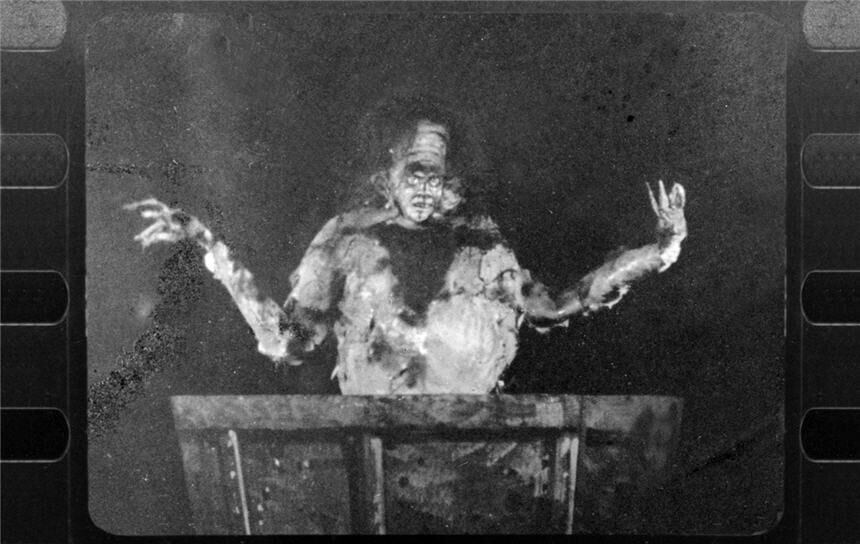This week we focus on an influential masterpiece of German Expressionism, Robert Weine's 1920 horror film The Cabinet of Dr. Caligari (Das Cabinet des Dr. Caligari). Like many of the great silent films of the era, Caligari is in the public domain, and available to watch for free (in versions of varying quality) on YouTube, Netflix, archive.org, and other sources.
I'm not a film scholar, the only qualification I have when it comes to writing these reviews is that I am a film enthusiast. I'm not going to pretend for a moment that I have a comprehensive grasp of German Expressionism. (Really, I don't.) That being said however, I do feel the need to expound on German Expressionism. (Especially so since this article is a review for what is considered by many to be the quintessential film demonstrating the period.)
Expressionism emerged at the turn of the 20th century, a time of great societal change and a perfect storm of challenges—in philosophy, psychology, politics, socio-economics, linguistics, and in the arts—to the individual's understanding of reality and his place within it. Expressionism had its roots in the 19th century—in philosophers like Nietzsche and Marx, and in artists like Van Gogh and Munch—and flourished in the early 20th century.
And then, of course, the movement was strongly influenced by the unimaginable horrors of the First World War (1914-1919), which saw kingdoms and empires broken, effectively reshaping Europe both physically and socially. World War I turned the dehumanizing tools of the Industrial Revolution into an efficient way to kill some 16 million people. In the years after the war, Expressionism took on a more political air, becoming a means of exploring both personal alienation and the need for political and cultural revolution.
―
The Expressionists moved away from strict realism and external representation to prioritize the experiences of the artist. Where the Impressionists had tried to translate the external world through the artist's perceptions, the Expressionists sought to make the inner turmoil of the artist external: they prioritized emotion over intellect, subjective reality over objective, and symbolism over literalism.
What we call "German Expressionism" flourished in the era of the Weimar Republic, the government in place in Germany between the end of the First World War in 1919 and the rise of the Third Reich in 1933. I've even less of a German historian than I am a film historian, but it was, from all reports, not a happy time: the revolutionary left and the radical right were at war with each other, and both were at war with the government, while the entire country—attempting to recover in every way from the horrors of the War to End All Wars—was suffering from skyrocketing inflation and widespread unemployment.
Weimar Germany was, however, a ripe environment for artistic expression, due to a fertile combination of communal trauma, passion for change, and creative liberty. The Weimar government had removed many of the previous administration's censorship laws and restrictions, and so a period of social, sexual, and artistic freedom emerged. The new art form of cinema was under more severe restrictions than other media—films were still produced under the banner of a state-run film studio, Ufa—but this system produced incredible, innovative early works from directors like F. W. Murnau (Nosferatu), Fritz Lang (Metropolis), and even Billy Wilder (who collaborated on Robert Siodmak and Edgar G. Ulmer's People on a Sunday).
None of this, of course, is essential knowledge for appreciating Robert Weine's The Cabinet of Dr.Caligari—written by Carl Mayer and Hans Janowitz—one of the earliest and most successful of the Ufa films. In fact, I think you can note many of the goals and obsessions of German Expressionism just from watching the film, and experiencing its jagged, threatening aesthetic, its violent and psychologically tortured story, its uncertain and uncomfortable relationships to authority and reality. (Or you can just enjoy it as an early, creepy, creative, darkly visionary movie.)
The film opens with a framing sequence: a young man and an older man are sitting in a garden, sharing stories. "There are spirits everywhere, they are all around us," the old man—who looks rather mad—says. "They have driven me from hearth and home—from wife and child." We receive—and will receive—no explanation for this extraordinary claim, because they are interrupted by the arrival of someone who seems to be one of those spirits: an ethereal figure in white who wanders trancelike from the furthest depths of the shot, nearer and nearer, until she moves to the foreground and out of sight. "That is my fiancée," the young man says, and launches into his own story, propelling the audience deeper into the nightmare fevered landscape of a dream like world that touches a nerve in the human psyche, causing one to question the sanity of the films creators.
One of the things that amazed me on first viewing of The Cabinet of Dr. Caligari is its relatively sophisticated narrative structure, unusual for films of the time: it was one of the first films, for example, to employ flashback, and narratives within narratives. One of Weine's favorite transitions is an iris effect—blackness closing in until the screen is reduced to a tiny circle of focus, and then opening again on another scene—and he employs it brilliantly here: he closes in on the storyteller's face, and then out to show the brighter landscape where the story will take place, and then back in to the storyteller. It is a way to make clear to his viewers that we are now shifting into the world of the young man's story—and for all I know, they had never before been asked to process such a visual narrative leap—but it's also wonderfully evocative: it's as though we are drifting in and out of sleep, in and out of the worlds of reality and nightmare, and we're not quite sure which world is which.
You will have to view the movie yourself for and make your own conclusions. I will not post the synopsis here. (Spoilers)
The story ends happily.
Except it doesn't. This is perhaps the earliest use of the twist ending that went on to inspire modern directors like Eli Roth, and M. Night Shyamalan, we emerge back in the framing sequence, with Francis telling his story to the old man. (And no, the original framing sequence is NOT the twist ending; that is still coming.)
Go watch the film now if you have not yet seen it…spoilers posted below! Go on, I’ll wait here…
Welcome back!
The framing sequence, which upends the main narrative, was forced on the filmmakers by the studio, which feared that the original story of the murders would prove too dark and disturbing for audiences at the time. Ufa asked director Fritz Lang to come up with an idea to soften Weine's film, and Lang suggested this ending, in which there were no murders, just the delusions of a sick young man.
Apart from this evidence that studio interference is as old as cinema itself, I find the framing sequence fascinating, and I'm not sure it subtracts from the film as much as many critics seem to think. On the one hand, yes, it distorts the intention of the film: instead of a story in which the old establishment figure—the character of the Director—is proven to be corrupt and evil, it becomes a story in which the young (presumably liberal) student is shown to be delusional.
Instead of a story in which authority is overthrown, and the old order is questioned, we now have a story in which authority is reinforced, and order is restored.
And yet the studio-imposed framing sequence adds an additional layer of narrative uncertainty that, to me, makes The Cabinet of Dr. Caligari far more interesting than it might otherwise be, and—in a way—far more subversive. One of the things that fascinates me about this is that Ufa believed this ending somehow made the film more palatable: as though audiences would be comforted to learn that our heroes—our romantic leads—were both completely insane, and that everything we had believed to be true was a lie. Perhaps German audiences at the time did find the restoration of order and authority at the end of The Cabinet of Dr. Caligari to be comforting: I find it far more nihilistic and unnerving than the original ending might have been. After all, though the Director says he can now cure Francis, no such promise is made about Jane, so the happy ending—the Romantic ending, the promise of peace and joy that Jane represented—has been destroyed. And where is Alan? The story we have watched becomes even darker if we interpret it through this new ending: Caligari (the evil figure of authority) and Cesare (the monstrous expression of subconscious will) both become creatures of Francis's tormented psyche, who (at least in Francis's mind) murdered his best friend and rival for Jane's affections.
So, in conclusion, The Cabinet of Dr. Caligari is a must. A sophisticated, deep, dark, psychological thriller/mystery.
Film: *****
Effects: *** (Nothing of real note besides iris in/out and some set and directing tricks new for the time)
Soundtrack: *** (I found the film on Archive.org and the soundtrack was not bad/distracting from the story - as is the case sometimes in older films.)
Story: ***** (Wow. Complex story telling on par with modern films? Count me in!)
Overall: 4 stars! Great film to enjoy any time of year not just at Halloween!





